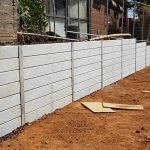Introduction
Building a retaining wall can be a fantastic method to enhance your landscape, control disintegration, and develop functional area. Nevertheless, before you dive into this task, it's vital to comprehend the licenses and guidelines that use. Working with a retaining wall installer or contractor who is skilled in these requirements can save you time, cash, and headaches down the line. This post intends to direct you through browsing the intricacies of structure licenses and compliance regulations associated with maintaining walls. Together we'll check out the diverse aspects of permitting procedures, the function of different types of products like concrete sleepers, H beams, wood sleepers, wood sleepers, and stone to name a few.
Understanding Authorizations and Laws with Your Retaining Wall Installer
When you're preparing to build a retaining wall, among your first discussions should be with your retaining wall builder about local zoning laws and building codes. Not all towns have the very same requirements regarding retaining walls; hence comprehending these regulations is paramount.
What Are Building Permits?
A structure permit is essentially an official approval from your local government that permits you to continue with building work. This file makes sure that your task complies with regional codes created to safeguard public security, health, and welfare.
Why Do You Required a Permit for Your Keeping Wall?
Safety Compliance: Ensures structural integrity. Legal Defense: Secures against future liabilities. Community Standards: Makes sure visual uniformity within neighborhoods.The Function of Your Retaining Wall Installer in Protecting Permits
Your retaining wall contractor will frequently play an essential part in protecting necessary permits. They are usually acquainted with regional regulations and can help you navigate through the documents required for submission.
Questions to Ask Your Installer About Permitting
- What permits are required for my project? Will you deal with the application process? How long does it typically take to protect a permit?
Types of Keeping Walls: A Quick Overview
Before diving deeper into permits and guidelines, it's essential to understand various kinds of retaining walls as they might have varying permit requirements.
Concrete Sleepers
Concrete sleepers are popular due to their resilience and low upkeep needs. They are often used in property settings because they provide exceptional resistance against weather conditions.
H Beams
H beams use extraordinary load-bearing capabilities, making them ideal for bigger projects where soil pressure might be more significant.
Wood Sleepers
Wood sleepers give a more natural visual however might require extra treatments for longevity versus rot.
Timber Sleepers
Similar to wood sleepers however usually thicker and tougher; timber alternatives likewise include a rustic appeal however might not have the same life-span as concrete alternatives.
Stone Maintaining Walls
Stone walls can be exceptionally beautiful however frequently need competent workmanship which might result in greater costs and more strict guidelines concerning setup methods.
Local Zoning Laws Affecting Your Project
Zoning laws dictate how land can be utilized within specific locations. Comprehending these laws is vital when dealing with any construction job including keeping walls.
Setback Requirements
Most jurisdictions have setback requirements that dictate how far back from home lines structures should sit.
Example:
|Location Type|Minimum Problem|| -----------|----------------|| Residential|5 feet|| Industrial|10 feet|
Building Codes Connected to Keeping Walls
Building codes establish requirements for construction practices within your locality; violating these can lead to fines or even demolition orders.
Structural Stability Standards
Regulations often specify minimum heights for walls depending on their materials-- concrete sleep walls might have more stringent standards than wooden ones due to their weight-bearing capacities.
How Does Soil Type Impact License Requirements?
The type of soil on your home plays a substantial role in figuring out whether you'll need extra engineering assessments before constructing your keeping wall.
Question: What soil types most commonly impact maintaining wall construction?
Clay Sand LoamEach soil type has its own characteristics that might either support or weaken a maintaining structure's stability.
Engineering Considerations: When You Might Need an Engineer's Sign-Off?
In some cases-- especially if you're developing a taller or more intricate wall-- your municipality may need plans signed off by an engineer or designer before issuing permits.

Cost Implications of Permits and Laws on Your Project Budget
Understanding the expense ramifications associated with permits can influence your total budget significantly.
Breakdown of Prospective Costs
Application Costs: Varieties from $50-$500. Inspection Fees: Varies based on locality. Engineering Costs: Can vary from $200-$2000 depending on complexity.Timeline for Securing Licenses: What To Expect?
The timeline can vary extensively based upon region; nevertheless, here's what you might anticipate:
Pre-application meetings (if needed) Submission review (1-4 weeks) http://lukasfencingbusinesskdoc130.fotosdefrases.com/case-research-study-how-one-homeowner-transformed-their-yard-with-a-trusted-retaining-wall-contractor Approval & & License issuance (1-8 weeks)FAQs About Keeping Wall Installation
1. Do I require a permit for a small retaining wall?
Yes! Many jurisdictions need licenses even for smaller structures because they still effect drainage patterns and home lines.
2. The length of time does it take to get a permit?
Typically in between one week to numerous months depending on local policies and complexity involved in the project.
3. Can my installer handle all permitting tasks?
Often yes! Numerous knowledgeable contractors handle this process as part of their service offering.
4. What happens if I don't acquire a permit?
You risk of dealing with fines or being ordered to take apart an unpermitted structure.
5. Exist different requirements for various materials?
Yes! Particular materials might have distinct structural code requirements which could impact permitting procedures considerably.
6. How do I find out about regional zoning laws?
Visit your regional community office or check their website where zoning ordinances are typically posted online!
Conclusion
Understanding permits and policies with your retaining wall installer is not almost administration; it incorporates safety, neighborhood standards, and eventually safeguarding your financial investment! By approaching this task thoughtfully-- with open lines of interaction in between yourself and certified specialists-- you'll pave the way toward successfully completing your task while sticking strictly to all legal requirements surrounding it! Whether you're choosing concrete sleepers, wood options like timber sleeper walls, or grand stone building and constructions-- being informed will always make your journey smoother!